How To Use Lmms To Make Music
LMMS is a free Digital Sound Workstation (or DAW) that works on Linux, Windows, and Mac. Information technology's a good pick to brand music with, and many say it's the closest thing you tin get to FL Studio for gratuitous. Some other bully feature is you can use your calculator keyboard as a MIDI controller. If you desire to learn how to use this DAW in a applied tutorial, keep reading.
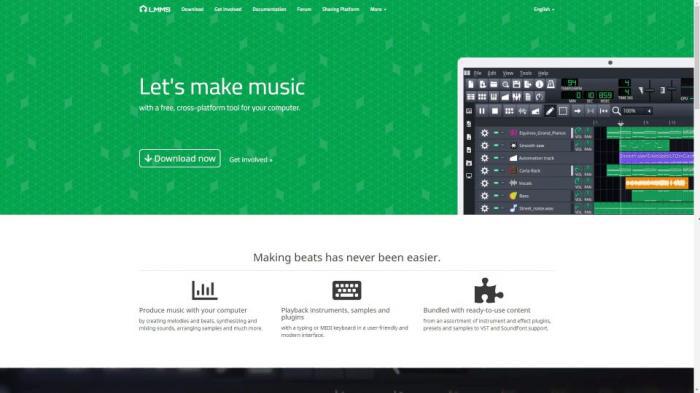
If y'all're wondering what LMMS stands for, the software was formerly known as Linux MultiMedia Studio.
A Cursory Introduction of LMMS
Let's get into the settings outset. And then we'll move on to the layout of the DAW, and then you know what everything does and where everything is. Go upward to Edit in the top left and down to Settings.
At that place are two things you may want to modify right abroad. First is "Enable note labels in the piano ringlet," which volition aid you know what notes you're using when writing music. The other is "Language" at the bottom, which may be skillful to change if y'all read a different one meliorate than English.
Moving on to "Directories," this is where you tin set up the folders that LMMS looks in for your files. These would be your plugins, Soundfonts, and other things similar themes and background art. Samples are handled differently.
There are Performance Settings and Sound Settings, where you can set your sound interface, and the last is MIDI settings. One time you're done, press OK at the bottom, and if yous want, you can restart LMMS now, only it'south unnecessary for this tutorial.
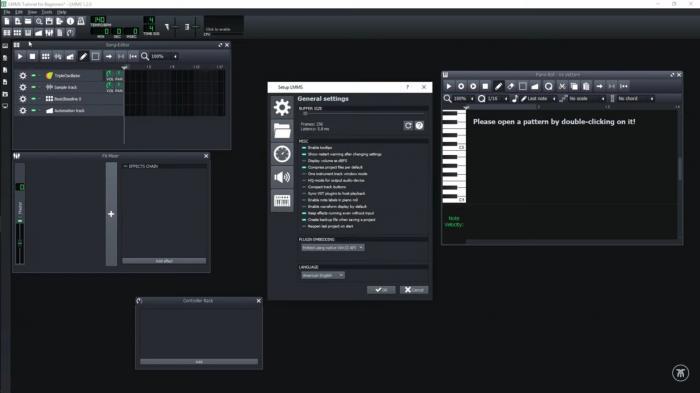
How to Make Music: Layout of LMMS
The Layout in LMMS is very customizable and is a sandbox. Yous become unlimited space to expand the piece of work expanse when you movement windows farther out in any management. And, it will compress dorsum down as you movement them towards the center once more.
Closing a window within the DAW will not erase anything. Information technology's pretty much minimizing information technology.
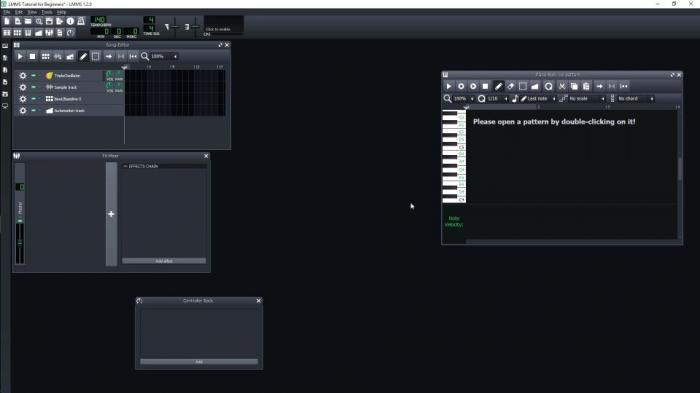
Making Music By LMMS
How to Make Music Using LMMS: Toolbar/Transport bar
On the peak, you'll find the toolbar, which holds some shortcuts to the top menus like File, Edit, etc. These are for creating new projects and opening exzig. These are for creating new projects and opening existing ones, saving, exporting, and even a cool info button where you tin can click on information technology, then on someone you desire to learn about, and it will tell you what it does.
Below the shortcuts for the File menu are the ones for the View menu. These are for all the windows y'all'll need to create or edit sound. The transport section to the right of the toolbar options shows you lot information virtually the arrangement. Click on the position to change it from "time" to "measure out," and you tin can either double click, click and drag, or whorl to change the balance. To the right of those are the primary volume and primary pitch. And then you accept a CPU meter which yous can enable by clicking on it.
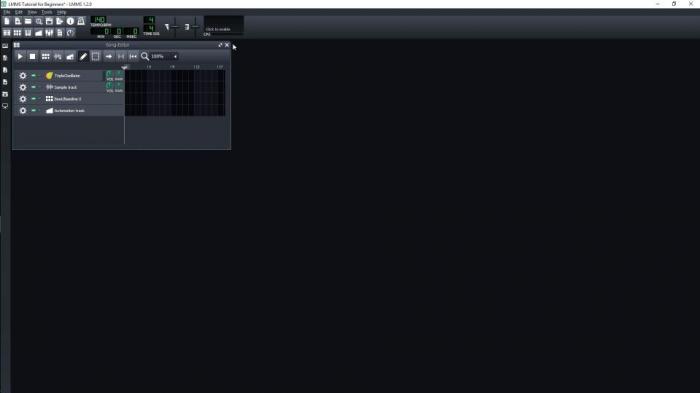
How to Make Music Using LMMS: Media Browser (Samples, Sound effects, & plugins)
One last thing before I motility on to the windows like the pianoforte scroll and mixing console. On the left side of the DAW, you lot'll find the Media Browser. Here is where your virtual instruments volition be, your projects volition be, the samples and presets that come with the DAW, and the last two are directories for your computer.
These two are where yous'll need to navigate to the folders that hold all your samples or audio files you want to utilize in the DAW, such as loops, drums, etc. And what's cool is you tin can even navigate to your VST plugins this manner too. For both samples and plugins, you lot tin can drag and drop them from the folders directly into the song editor, also known as the playlist. Or the beat+bassline editor, too known as a pace-sequencer
How to Make Music Using LMMS: Song Editor / Playlist / Sequencer
The option to the left opens the song editor, which is a timeline to arrange dissimilar patterns and audio. Equally I said, you can drag and drop plugins and samples into this to assign them to their track in the playlist. You can also add things like the beat out+bassline editor, sound files, and automation tracks from the toolbar in the vocal editor. Then, you tin can re-arrange the gild of tracks if yous want past clicking and dragging on whatsoever role that doesn't have a button or parameter.
On each track, you accept an options carte which is different for each type of track, a mute and un-mute button, a solo button (which mutes every other track), the name of the track (single click to open its window and double-click to rename it), then for VST tracks (and audio tracks), there is a test button. Lastly, there are the book and pan parameters. And y'all can hold SHIFT, so click and drag to resize a rails vertically.
For the timeline section. Left-click on a bar to create a pattern, right-click to come across more options, center-click to delete information technology, and hold CTRL and center-click to mute the blueprint. You can drag them around, and information technology will tell you what bar they're on, and pressing CTRL then dragging volition duplicate the blueprint yous've selected. To edit what is in a pattern, double click, and it will open the editor specific to what kind of runway it is.
Except for the beat+bassline editor, each design is unique, and the changes yous brand are separate from the residual, even if it was originally a duplicate of something else.
MIDI patterns volition grow and shrink to fit the length of notes in it, but all other tracks can exist resized manually by clicking and dragging from the right side of the blueprint. Although, Beat and Bassline editor tracks are the only ones to keep duplicating every bit y'all drag them out.
The arrow and line are where the song will play and tin exist moved effectually by left-clicking once or dragging along the bar counter on the pinnacle. Playing and stopping can be done from the toolbar but tin also exist done by pressing the Space bar, as long as the song or automation editor was the final window clicked.
You lot can gear up loop points past enabling it on the toolbar, move the endpoint past right-clicking once or dragging along the bar counter, and set the starting time point by doing the same while property down SHIFT. As for the rest of the carte buttons, y'all can toggle between Draw mode and Select mode, auto-scrolling, and what will happen when you press stop.
How to Make Music Using LMMS: Beat/Bassline Editor / Step-Sequencer
The beat and bassline editor is like a mini-song-editor and will take its rail in the actual song-editor. For the most part, it's nevertheless, merely there are some differences. The play and stop buttons for the stride sequencer are for this window specifically and not the song editor.
Each block is a beat or MIDI notation, and you tin can left-click to enable or disable a note for each i and right-click on any of them to show the options for that rail. For example, you tin can prove the piano scroll, giving y'all a better perspective of what this is.
Past default, at that place are 4 bars, but you lot can add 4 more with the choice, clone what you take with this one, or remove four of the last 4 bars with this option. As I said, these are the same as notes on a piano roll. And in most cases, y'all're going to want to apply that instead.
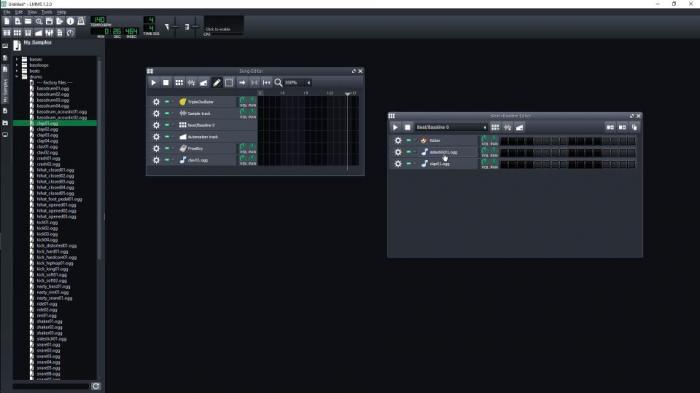
How to Make Music Using LMMS: Piano-Coil / MIDI Editor
If you're dealing exclusively with the piano roll for making a melody or something, yous would want to go back to the song editor for this. Brand a pattern on a VST track, right-click, and open the pianoforte gyre. This thing is and then piece of cake to utilise, and at that place are many features you can accept advantage of.
With Draw mode enabled, you lot can place notes by left-clicking and delete notes by correct-clicking (and dragging if you want to delete multiple notes). Property CTRL and left-clicking while dragging lets you select multiple notes, belongings shift and dragging lets you lot duplicate notes, and property SHIFT and CTRL lets you add together selections together by either clicking on or dragging over notes.
Then, that makes Erase Mode and Select Mode useless. But, there is another one called Pitch Bend Mode. With it selected, click on a note to open the automation editor for information technology exclusively, fifty-fifty if the annotation is in a selection of other notes.

How to Make Music Using LMMS: Automation-Editor
The automation editor in LMMS is pretty straightforward. This is where you can create automation patterns that can change settings over time.
Left-click will place an automation point, and right-click will delete one (merely you tin also delete multiple notes in i go by left-clicking and dragging). You can flip the automation pattern horizontally, vertically and can change how each point transitions to the other, including the tension when the Bend is selected. Finally, you have the horizontal and vertical zoom and quantization, which is just where each point will snap horizontally.
You'll probably desire to stick to whole numbers when changing the vertical position of each point every bit these are semitones, and that is what each notation will exist.
Automation clips may also take their runway in the song editor depending on what parameter you automate. And, you'll need to make a new automation track for each parameter y'all want to change if that's where information technology's going to exist. However, something similar the pitch bend is non. That is handled within the piano roll, as you can encounter.
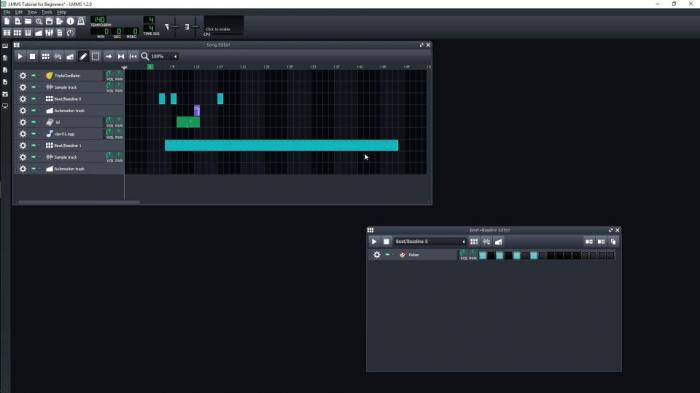
How to Make Music Using LMMS: Piano Gyre (Continued)
Let'due south get dorsum to the pianoforte curlicue. Just like the automation editor, you have zoom and quantization. But you can besides cull how long the note will be when yous draw it, the scale you're using, and what'south crazy is you have the selection to write in chords with ane click.
Another astonishing feature is the ability to record from a MIDI controller, right into the piano roll, either on its own or every bit the balance of the song is playing. And yes, this includes your computer keyboard AND will play chords from a single key if you have one selected.
The final thing I want to testify yous in the pianoforte roll is the note velocity (or volume) and panning of each annotation. These are both at the bottom and can exist switched back and forth past clicking on the left and tin can be resized by dragging the top of its section. Each note can be changed separately or together while being selected too. Alright, and so now that you lot have some audio going on, y'all may want to mix it at present.

How to Brand Music Using LMMS: FX Mixer / Mixing Console / Mixer Rack
This is the mixing console or mixing rack, which is chosen the FX-mixer in LMMS. Unfortunately, this is where the DAW lacks features, and musical instrument tracks are the but ones that can be routed to this window. But, you can still change the volume of audio tracks from the song editor and add furnishings to them by clicking on the track'southward proper name.
Every bit for what's going on in the mixer track, y'all can add new tracks by using the plus icon or by going to the song editor, then to the options of an instrument track and assigning it to a new runway that way.
The master track is the output of the entire DAW, and all other tracks are sent to it past default. Yous can disconnect a rails from information technology or change the amount beingness sent, and you tin also send tracks to other tracks, not merely the primary. This would be good for a hybrid bus, for example.
Each track has a book slider (oft called a fader) and controls the decibel level of everything sent to that rail. And yes, y'all can have more than one musical instrument track sent to a unmarried mixer track.
In a higher place the fader are the mute and solo buttons, the name, and the tracking number. Right-click to run across the options for the rails. Last is the consequence chain, which is unique to each track. But, the master would apply its effects to every track. So if you had reverb on the chief, every other runway would have reverb on it too.
You lot have them on and off buttons for each effect and the entire effect chain. You can add an effect with the push button on the bottom. Correct-click an effect to come across the options and press controls to run across the plugin.
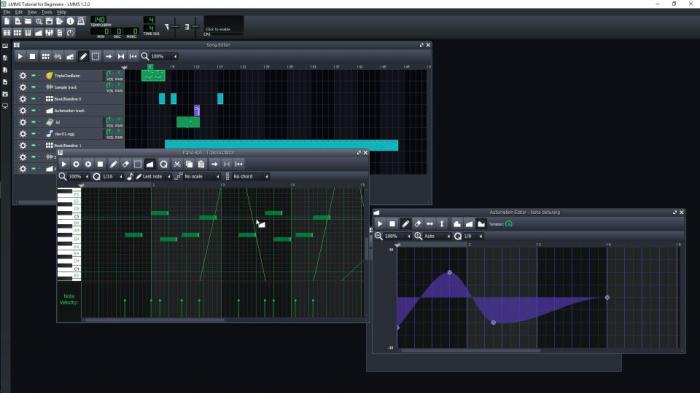
How to Brand Music Using LMMS: Project Notes / Notepad
LMMS also comes with a Projection Notes window and so yous can write down information about your project. It's got a lot of features for a notepad, and for some odd reason, information technology's super customizable.
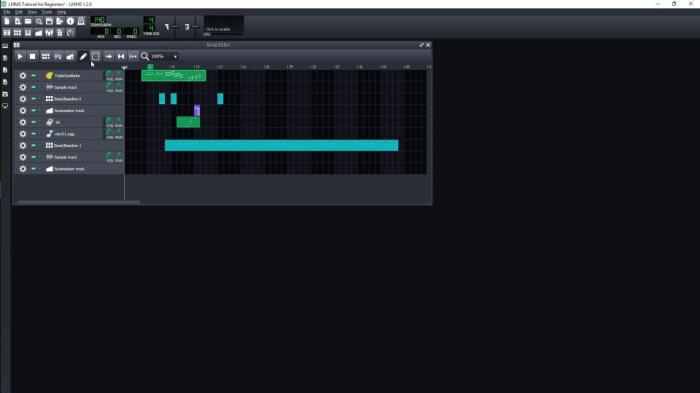
How to Brand Music Using LMMS: Controller Rack
The concluding window in LMMS is the Controller Rack. However, its nuts are an LFO (or low-frequency oscillator) that will change parameters over time.
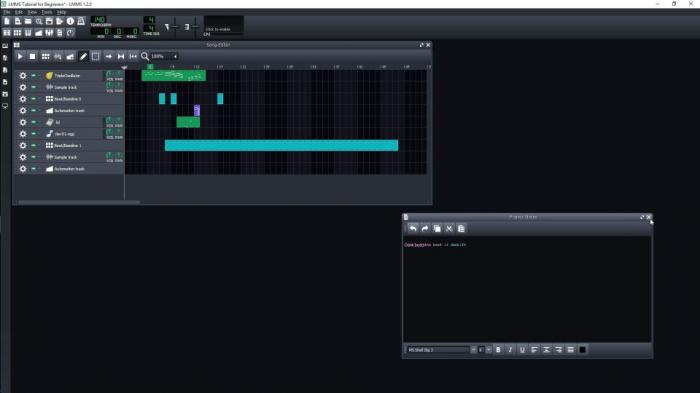
That's it for this LMMS tutorial for beginners.
How To Use Lmms To Make Music,
Source: https://sothinkmedia.com/how-to-make-music-using-lmms-tutorial-for-beginners
Posted by: baltzcoonly63.blogspot.com


0 Response to "How To Use Lmms To Make Music"
Post a Comment